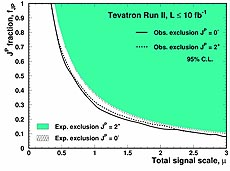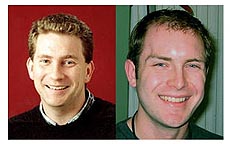Joining forces to test the Higgs boson's spin and parity
 |
| This plot shows
the observed and expected upper limits at the 95 percent credibility
level on the fraction of exotic boson production for two cases (spin
zero with negative parity and spin two with positive parity). A signal
scale of one corresponds to the Standard Model. |
The Higgs boson caused a lot of excitement when the ATLAS and CMS
collaborations announced its discovery in 2012. Everyone was
bursting with questions: How much does it weigh? How is it made? How
does it decay? Does it have any spin, and if so, how much? Does it look
the same in a mirror or not (the question of "parity")?
The Standard Model predicts the answers to all of these questions,
although some depend on the Higgs boson mass, which ATLAS and CMS have
measured precisely. So far, the new particle observed at the LHC is consistent with all of the Standard Model's
predictions. In particular, ATLAS and CMS's measurements of the spin and
parity allowed them to confidently identify the new particle as a Higgs
boson.
The Tevatron experiments, CDF and DZero, also found evidence for a Higgs boson in 2012, looking at
events in which two bottom-flavored jets recoiled from a vector boson
— either a Z or a W. All the same questions come
up, as some models predict that one may observe a mixture of Higgs
particles at the Tevatron different from what was observed at the LHC
due to the different mixtures of production and decay modes that
provide the most sensitivity.
At the Tevatron, the Higgs boson's properties were found to be consistent with those predicted for the Standard
Model Higgs boson. Theorists provided a clever way to test some models of the Higgs boson's
spin and parity using Tevatron data: Higgs bosons with exotic spin and
parity would be produced with more energy than the Standard Model
version. CDF and DZero looked at the energies and angles of particles
produced in Higgs boson events to check. But most events at the Tevatron
are non-Higgs-boson background events, so a lot of hard work went in to
test the models.
Both DZero and CDF modified their Higgs boson analyses to search
for the new particles, if they are present in addition to the Standard
Model Higgs boson, or if they replace it entirely. Neither experiment
found evidence for the exotic states, and the data prefer the Standard
Model interpretation.
But a much stronger statement can be made when CDF and DZero join
forces and combine their results, using the same techniques used in the
Standard Model Higgs search combinations. The signal strength of exotic
Higgs bosons in the JP=0- and 2+ states is no more than 0.36 times that
predicted for the Standard Model Higgs boson. Given a choice between the Standard Model Higgs boson, which has JP=0+, and one of the two exotic models replacing it
with the same signal strength, the Tevatron data disfavors the exotic
models with a significance of 5.0 standard deviations for 0- and 4.9
standard deviations for 2+.
The figure above shows limits on the fraction of exotic Higgs boson
production as functions of the total signal rate, assuming that the
Higgs signal is a mixture of the Standard Model Higgs boson and one of
the exotic kinds. The particle for which the Tevatron experiments
reported evidence in 2012 is consistent with having the spin and parity
predicted by the Standard Model.
—Tom Junk
Learn
more
 |
| Tom Junk
(Fermilab) of the CDF experiment made significant contributions to this
result. |
 |
| Gavin Davies
(Imperial College London) and Wade Fisher (Michigan State University),
both at DZero, made significant contributions to this result. |
|